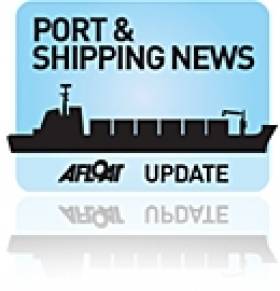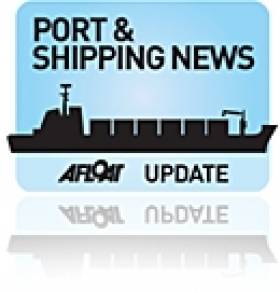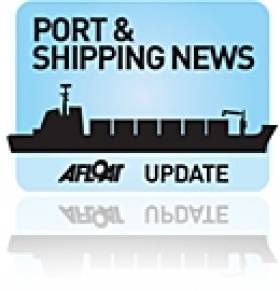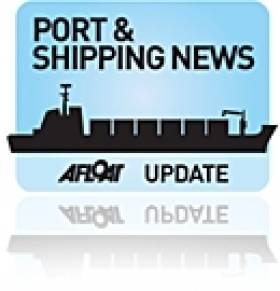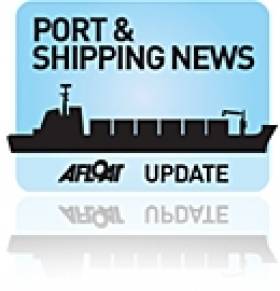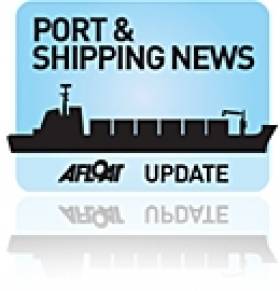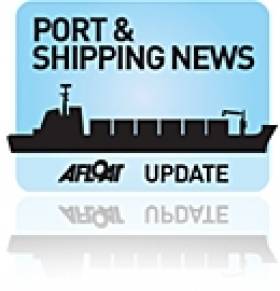Displaying items by tag: Port and Shipping News
IMDO Market Review: Galway Port Plan Hearings, Antwerp’s Record Year, China’s 2020 Shipping Roadmap and Much More
#Ports&Shipping –The latest IMDO Weekly Market Review includes the following stories as detailed below.
Irish Shipping News: Hearing into proposed Galway Harbour expansion taking place - A preliminary hearing into a proposed expansion of Galway Harbour has been taking place ahead of the full An Bord Pleanála oral hearing. As previously reported on Afloat.ie, the planned development would cost €126m. The first module will deal with issues relating to ecology and hydrology. Subsequent modules will look at other issues and include questioning and cross-examination of witnesses.
Global Maritime News: Port of Antwerp set for record year - The Port of Antwerp is expecting container volume growth to help drive the port to a year of record volumes. Europe's third busiest container port's estimated throughput figures show it is likely to handle 8.96m teu this year, an increase of 4.5% compared with 2013. As a result, the port is likely to break the 9m teu mark over the coming 12 months.
China outlines 2020 roadmap to develop China shipping sector - China's ministry of transport has spelled out a roadmap to 2020 on the development of its shipping industry, in a bid to raise the sector's level of services and global competitiveness. The seven-page guideline broadly states that China will focus on improving its policies to benefit shipping enterprises, sharpening technology and innovation, boosting financial services and strengthening ancillary services.
Panama Canal announces new toll structure - The Panama Canal Authority (ACP) has announced a proposal for a new toll structure and is inviting formal comments on the tolls. A public hearing will take place on 27 February, written comments must be received by the deadline of 9 February at 1615hrs, local time.
For more on each of the above and other stories click the IMDO Weekly Markets Review (Week 2). In addition to dedicated coverage on Afloat.ie's Ports & Shipping News section.
Port & Shipping Review: State Papers Reveal Row over ISL Liquidation, Livestock Rise to UK, Car Carrier Aground, 200 Jobs to Expand Galway Port and More…
#Port&ShippingNews - Over the last fortnight, Jehan Ashmore has reported on the shipping scene, where State papers from 1984 reveal a row in Government over the liquidation of Irish Shipping Ltd.
In 2014, over 16,500 animals were exported to Britain, a rise of nearly 65% compared to last year according to Minister for Agriculture Simon Coveney.
Hoegh Osaka, a car-transporter ran aground on a Solent sandbank, all 25 crew were brought to safety.
200 jobs would be created in expanding Galway Port, a preliminary hearing was told ahead of An Bord Pleanala oral hearing.
A new 25,000dwt tanker, Ardmore Cherokee, joins the fleet of Ardmore Shipping Corporation.
The world's largest container ship, CSCL Globe makes UK port debut loaded with 19,000 standard containers.
Is Ireland a model to follow when it comes to maritime strategy? … yes, according to Dr. Simon Mercieca of the University of Malta, who says his country needs to take lessons from the Irish experience, having attended a conference in University College Cork.
World's Largest Containership CSCL Globe Calls to UK Port
#LargestContainership - The world's largest container ship, CSCL Globe arrived in the UK for the first time at Felixstowe, reports BBC News.
The Hong Kong-registered giant containership which measures more than 400m (1,313ft) in length, docked at the Suffolk port on Monday loaded with about 19,000 standard containers.
The previous largest ship to have docked at the port was the Maersk Triple-E, which arrived in November, carrying about 18,000 containers.
The new ship, which left China in December, arrived at the Suffolk port sometime after 12:30 GMT.
For further news including photos, vessel graphic and statistics, and photos of her nearest rivals, click the link HERE.
IMDO Market Review: Cork Harbour €1bn Makeover, US Port Congestion, China Deregulate Port Tariffs, European Banks Resume Lending
#Port&Shipping –The latest IMDO Weekly Market Review includes the following stories as detailed below.
Irish Ports: Cork Harbour to Get €1bn Makeover into 'Sydney of Europe' - Over 100 years of under-investment and problematic industrial projects has left Cork with a depressing harbour legacy. Now, however, under a landmark redevelopment programme by Marine Minister Simon Coveney, the aim is to transform Cork into the 'Sydney of Europe' by the end of 2018.
Global Maritime News: Long Beach and LA seek FMC permission to work together on congestion - The US west coast ports of Long Beach and Los Angeles have filed a petition with the US Federal Maritime Commission that will enable them to work together to help ease the flow of cargo. The ports want to collaborate with each other on matters including rail operations, chassis supply and storage, vessel calls, truck turn times and marine terminal operations.
Chinese Ports: China further deregulates port tariffs - China has moved closer to fully deregulating port tariffs in the government’s latest market-based reform, which analysts said will have positive but limited impact on terminal firms’ business operations. The Chinese transport ministry and National Development and Reform Commission will not set mandatory or guideline prices for terminal operators handling containers, dry bulk and passengers from next January.
European Banks: In search for yield, European banks hop back on board shipping industry - European banks are resuming lending to shipping companies after staying away from the industry since the financial crisis, as seen on Hellenic Shipping News. Germany, British, French and Norwegian banks were traditionally predominant lenders to the capital-intensive industry until 2008, when the crisis sent several high-profile lenders into distress, leaving their shipping portfolios with non-performing loans.
Irish Exports: Ireland granted full access to US beef market - Ireland is to be the first European country to be granted full access for its beef in the US market after the US lifted a ban on European beef imports. The ban had been in place for almost 16 years, since the BSE crisis in the 1990s. The announcement represents a multi-million euro boost for the Irish beef industry.
For more on each of the above and other stories click the IMDO Weekly Markets Review (Week 1). In addition to dedicated coverage Afloat.ie's Port & Shipping news section.
IMDO Market Review: Over-Tonnage Low, UNCTAD Rank Nations Fleet, Obama Under Pressure, Dutch Dockers Unite over Automation and More
#Ports&Shipping –The latest IMDO Weekly Market Review includes the following stories as detailed below.
Global Shipping & Ports: Over-tonnage and ECAs Drag Shipping Confidence to Two-Year Low Confidence among the shipping industry has dropped to its lowest point in two years, spurred by on- going uncertainty over markets, upcoming sulphur regulations, and over-tonnage. The results, which ranks confidence on a scale from 1-10, showed that overall levels dropped to 5.7 from 6.1 in the three months leading to November.
UNCTAD: Greece, Japan, China and Germany are still the dominant world fleet ship-owners - Japan, China and Germany are at the forefront of many rankings, such as the world's largest economies, largest manufacturers, largest traders. Greece is nowhere near attaining those characteristics, and is often one of the smallest. However, the Greek-owned fleet of ships remains at the top of the global ranking of ship-owning nations.
Obama Ports Negotiations: Obama under pressure to step in on port negotiations - US President Barack Obama is under increasing pressure to take action on the west coast port negotiations after a group of seven members of congress urged him to step in. A letter written by the seven members of congress has urged President Barack Obama to encourage the International Longshore and Warehouse Union and the Pacific Maritime Association to use a federal mediator.
Rotterdam Dockers: Dockers unite against Dutch automation plans - European dockers joined forces this week in Rotterdam to protest against the port's plans to expand as concerns over job losses on the back of increasing automation mount. This comes as ITF-affiliated union FNV Havens expressed its concern over the potential loss of employment and reduced working conditions as a result of an increase in automation and the expansion in capacity from Rotterdam World Gateway.
For more on each of the above and other stories click the IMDO Weekly Markets Review (Week 51). In addition to dedicated coverage on Afloat.ie's Ports & Shipping News section.
Ports & Shipping Review: Brave Newbuild Launched, Ferry Trials Deep Down Irish Sea, Agreement on CO2 & Sister of Final H&W Built Ship Debuts in Dublin
#Ports&ShippingReview – Over the last fortnight, Jehan Ashmore has reported from the shipping scene, where Arklow Shipping's fifth out of six 'B' class 'green' newbuilds Arklow Brave was launched in the Netherlands.
Another newbuild, German built Loch Seaforth carried out sea trials in the Irish Sea for Scottish ferry operator CalMac, which involved departing the Clyde and heading south as far as the Codling Bank offshore of Wicklow Head.
The Permanent Representatives Committee reached agreement with European Parliament on new EU-wide rules regarding CO2 emissions from ships.
A sister of Anvil Point, the last ship to be built in Belfast by Harland & Wolff in 2003, the Dorset docked in Dublin Port having entered service for Colbelfret's (CLnD Ro-Ro) service from Zeebrugge.
#DorsetsDublinDebut – A sister of Anvil Point, the last ship to be built in Belfast by Harland & Wolff in 2003, the Dorset docked in Dublin Port last Friday having entered service for Colbelfret's (CLnD Ro-Ro) service from Zeebrugge, writes Jehan Ashmore.
Longstone since renamed Dorset, along with a sister Beachy Head, having been operated by Foreland Shipping were sold in April to C-Bulk Shipping, a subsidiary of the CLnd (Compagnie Luxemburgeoise de navigation SA).
Since spring 2013, the pair become surplus to the UK's Ministry of Defence (MoD) requirements as part of a Private Finance Initiative contract involving all six 'Point' class sisters.
The 23,235 tonnes ro-ro cargoship, having ceased a charter-contract to the MoD's Strategic Sealift command, required her to be ready in reserve to transport military equipment, vehicles and supplies in time of conflict.
Prior to the establishment of the Strategic Sealift, such difficulties were encountered by the MoD in securing such ships during the Gulf Wars.
It is understood that the conditions of the Private Finance Initiative of the Strategic Sealift contract had allowed for two of the six ships to be chartered for commercial purposes but available for armed forces given 30 days-notice.
A case in point being the charter of Longstone to that of DFDS Seaways, in which she ran the only ro-ro link between Scotland and Europe by serving on the North Sea route of Rosyth-Zeebrugge.
Despite her latest career change and guise as Dorset, it seems at least for now she that she is running out of the same Belgium port.
The 193m long Dorset which can handle 180 trailers, had made her inaugural Zeebrugge-Dublin sailing that is scheduled for a passage of 36 hours. Upon arrival in Dublin Bay, she took up a pilot from the cutter Liffey and berthed at the port's No. 2 link-span within Alexandra Basin East.
Fleetmate, Mazarine, the leadship of six German built con-ro sisters had previously docked in Dublin the night before having sailed on CLnd's second service from Rotterdam, taking slightly longer by 38 hours.
The ships on both routes are operated by CLnD whose Mazarine made her maiden voyage to Dublin Port and from where she was named in 2009.
The occasion was also notable as the CLnD 'Motorways of the Sea' routes are the first direct ro-ro freight service linking the Irish capital to Belgium and the Netherlands.
Mazarine carries double-stacked (854 TEU Mafi-container) cassettes, trailers, car and trucks across 3 kms of freight lane decks.
The decision to dispose of the Point pair followed a MoD review in 2011 of its Strategic Sealift requirements that has reduced this capability to the remaining quartet of Point sisters.
Of the four, Hartland Point, is the only other sister asides Anvil Point to have come from the yard of Harland & Wolff.
This left the rest of the series to be built in Germany, from the yard of FGS which as previously reported built CalMac's latest newbuild 'flagship' car ferry Loch Seaforth. She returned to her Scottish base of Inch Green yesterday after latest sea-trials.
Those attending the annual Southampton Boat Show held on Mayflower Park, may of noted on the far side of the River Test is a jetty. This is a UK government military facility at Marchwood Military Port, where Anvil Point and Eddystone are currently based on duty.
Finally is the Hurst Point which represents the sixth of the Point Class series. Likewise of Longstone (Dorset) she was commissioned for Andrew Weir Shipping (AWSR), the original owners of these ships.
IMDO Market Review: Dredging Difficulties, IMO Reduce Admin, Tanker Boom, Safeguarding the Arctic, Mega ‘Box’ Alliances and Much More
#Ports&Shipping –The latest IMDO Weekly Market Review includes the following stories as detailed below.
Irish News: Sligo Harbour Dredging Difficulties - Earlier this year, the Department of the Environment granted a licence to Sligo council to allow them to undertake dredging works at Sligo Harbour. However, Councillors were told that the money required for the next stage of Sligo Harbour acquiring its Dumping at Sea Licence was not available.
Legislation: IMO Council agrees recommendations to reduce administrative burdens - The International Maritime Organisation's (IMO) Council agreed on a number of recommendations for action on the administrative burdens that may result from compliance with IMO instruments. The consultation gathered data from a broad spectrum of stakeholders. IMO recognizes that some administrative requirements may have become unnecessary, disproportionate or even obsolete, and is committed to reducing their impact.
Tanker Markets: Storage Boom for Tankers from Oil Price Collapse - The oil price drop will hand tanker markets an unexpected bonus next year, boosting demand for oil storage at sea while distant eastern markets also bargain-hunt fuel and need shipping. Supertanker rates are already close to five-year highs of over $83,000 a day - helped by a drop in shipping fuel bunker prices.
International Ports & Shipping: Safeguarding the Arctic -The US Coast Guard has proposed a new shipping channel in the Bering Strait to protect Arctic seas. The 4.6-mile-wide route will be a two-way voluntary scheme stretching hundreds of miles as traffic increases in the area.
Alliances: Mega-alliance Agreements - From early next year the east – west container shipping trades will be almost completely dominated by four alliances. The 2M the vessel sharing agreement between Maersk Line and Mediterranean Shipping Co (MSC) recently unveiled its service network which will be phased in from mid-January, as will the Oceans Three alliance of CMA CGM, UASC and China Shipping.
For more on each of the above and other stories click the IMDO Weekly Markets Review (Week 50). In addition to dedicated coverage on Afloat.ie's Ports & Shipping News section.
Agreement of European Parliament On Monitoring CO2 Emissions from Ships
#CO2emmissions – An agreement between the Permanent Representatives Committee has been confirmed with the European Parliament on new EU-wide rules for monitoring, reporting and verification of CO2 emissions from ships. The agreement reached last month was through an informal trilogue.
International maritime shipping is the only means of transportation not included in the EU's commitment to reduce greenhouse gas emissions. Monitoring of CO2 emissions from ships is the first step of a staged approach to reduce greenhouse gas emissions in this sector as well.
The new regulation will improve information about CO2 emissions relating to the consumption of fuels, transport work and energy efficiency of ships, which make it possible to analyse emission trends and assess ships' performances.
For further information click PDF document here.
Arklow Brave Christened at Dutch Shipyard Launch
#ArklowNewbuild - Arklow Shipping's latest 'B' class newbuild which has a 'green' hull design form, became the fifth bulk general cargoship to be given a spectacular sideways launch yesterday at a Dutch shipyard, writes Jehan Ashmore.
The 4,800dwt newbuild is one of six ordered by ASL and the ship's christening took place at the Ferus Smit B.V. Netherlands shipyard in Westerbroek, which launched leadship Arklow Bank earlier this year.
As previously reported, Arklow Brave has a hull form was chosen to adapt to the 'bulbless' principle which provides for a slender-straight stemmed bow without bulb. Taking this into account the 119 m long vessel will be able to load various loads at different drafts and wave conditions. The performance of this bow will be better than a bulb optimised for one single-draft and flat-water only conditions.
When she is delivered in January 2015 to her Dutch based division, Arklow Shipping Netherlands N.V., the Rotterdam registered vessel will be deployed in the shipment of wheat, corn and serve in other bulk commodity markets.
So far the 'B' series ships have been given the names, Bank, Bay, Beach, Beacon and Brave, so what will the final member be called?


























